Scottish Water and its PFI partners use 199GWh of gas and fuel oil per year.
The majority of the gas is used in the thermal drying and processing of wastewater sludge.
Fuel oil is used for standby generation of power at our assets in the event of power supply problems.
The remaining gas is used for heating in our buildings.
This leads to 38ktCO2e per annum.

2019/20 POSITION
GAS AND FUEL
OIL USED
TOP 4 CONTRIBUTORS TO GAS AND FUEL CONSUMPTION
WASTEWATER SLUDGE
DRYING AT DALDOWIE
SLUDGE PROCESSING
AT SEAFIELD
STANDBY
GENERATION
3%
HEATING
BUILDINGS

MAXIMISE ENERGY
RECOVERED FROM
BIORESOURCE
REDUCE
CONSUMPTION
OF FUEL OIL
REDUCE USE
OF GAS
These tables illustrate the key activities we are
exploring to reduce our gas and fuel oil emissions.
We will keep these under review
with our expert advisory panel.
These tables illustrate the key activities we are
exploring to reduce our gas and fuel oil emissions.

UP TO
2025
• Consider rationalisation of buildings post COVID-19.
UP TO
2030
UP TO
2040
• Identify, assess and implement activities to replace sludge drying technology and alternatives to gas for sludge processing.
• Delivery of new solution at Daldowie to maximise value of bioresource.
• Maximise renewable generation from bioresource.
• Identify, assess and implement activities to maximise value of bioresource at returning PFI assets.
• Identify, assess and implement alternative technologies to replace standby generation on our assets (e.g. battery power).
• Complete implementation
of alternative technologies
to replace standby generation on our assets.
• Identify, assess and implement renewable heat sources for our buildings.
• Complete implementation of renewable heat sources for our buildings.
• Deliver Juniper House refurbishment as a net zero emissions building.

UP TO
2025
• Consider rationalisation of buildings post COVID-19.
• Identify, assess and implement activities to replace sludge drying technology and alternatives to gas for sludge processing.
• Identify, assess and implement alternative technologies to replace standby generation on our assets (e.g. battery power).
• Identify, assess and implement renewable heat sources for our buildings.
• Deliver Juniper House refurbishment as a net zero emissions building.
UP TO
2030
• Delivery of new solution at Daldowie to maximise value of bioresource.
• Identify, assess and implement activities to maximise value of bioresource at returning PFI assets.
• Complete implementation of alternative technologies to replace standby generation on our assets.
• Complete implementation of renewable heat sources for our buildings.
UP TO
2040
• Maximise renewable generation from bioresource.
DEVELOP ALTERNATIVE FUEL
FOR SLUDGE PROCESSING
DEVELOP ALTERNATIVE TECHNOLOGIES
TO STANDBY GENERATION
DEVELOP ZERO
EMISSIONS BUILDINGS
DEVELOP ALTERNATIVE FUEL FOR SLUDGE PROCESSING
DEVELOP ALTERNATIVE TECHNOLOGIES TO STANDBY GENERATION
DEVELOP ZERO EMISSIONS BUILDINGS
INNOVATION
CHALLENGES
DEVELOP ALTERNATIVE FUEL
FOR SLUDGE PROCESSING
DEVELOP ALTERNATIVE TECHNOLOGIES
TO STANDBY GENERATION
DEVELOP ZERO
EMISSIONS BUILDINGS
KEY ENABLER TO SUPPORT REDUCING
GAS AND FUEL OIL EMISSIONS
EXTERNAL FACTORS THAT SUPPORTS
REDUCING GAS AND FUEL OIL EMISSIONS
UK GAS NETWORK TRANSITION
from natural gas to biomethane
and hydrogen for heating
INTRODUCTION

TRANSFORMATION



ELECTRICITY

PROCESS
EMISSIONS

GAS &
FUEL OIL

TRANSPORT
& TRAVEL

INVESTMENT

STORING
CARBON
Scottish Water has established a framework for the supply of sustainably sourced hydrotreated vegetable oil that can be used by both Scottish Water and its construction partners. It’s a drop in fuel replacement that reduces emissions by 90% compared to conventional diesel.
Over the last year it has been widely adopted by our construction partners, displacing diesel use in excavators, cranes and other heavy plant. It is also being used to fuel generators to provide power for remote construction sites.
On our water mains rehabilitation programme its adoption is expected to reduce emissions by nearly 30%.